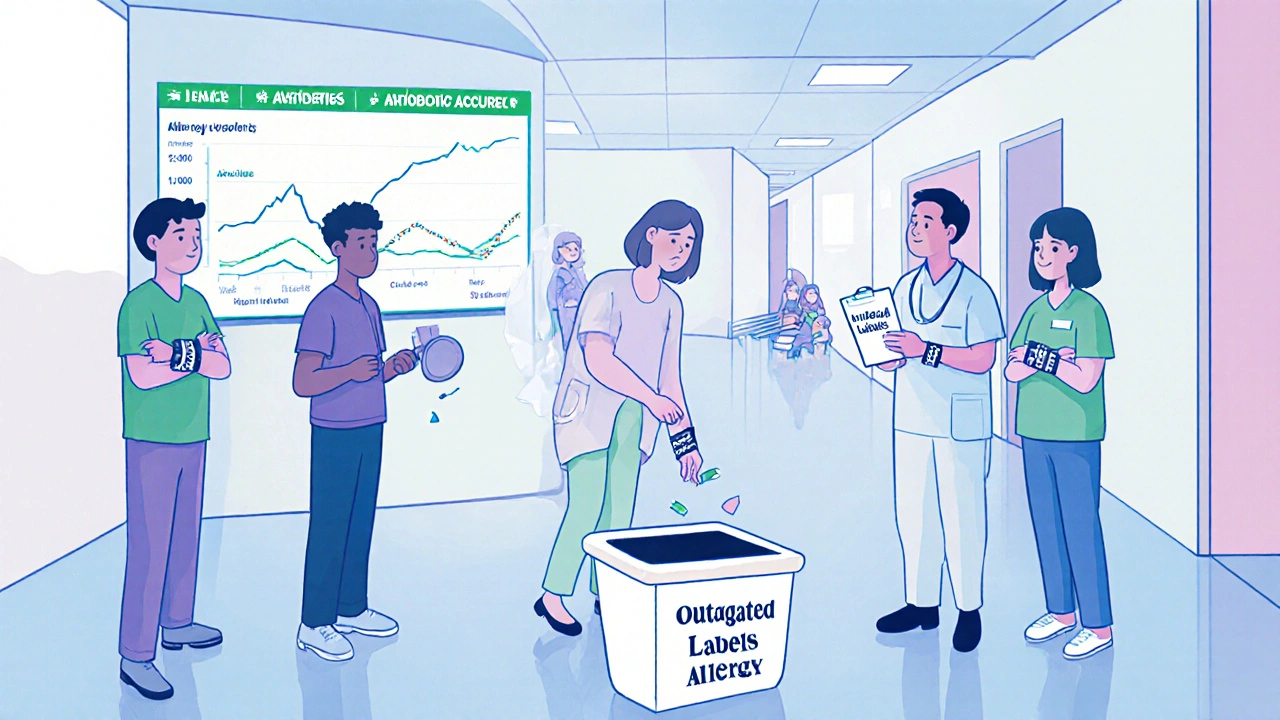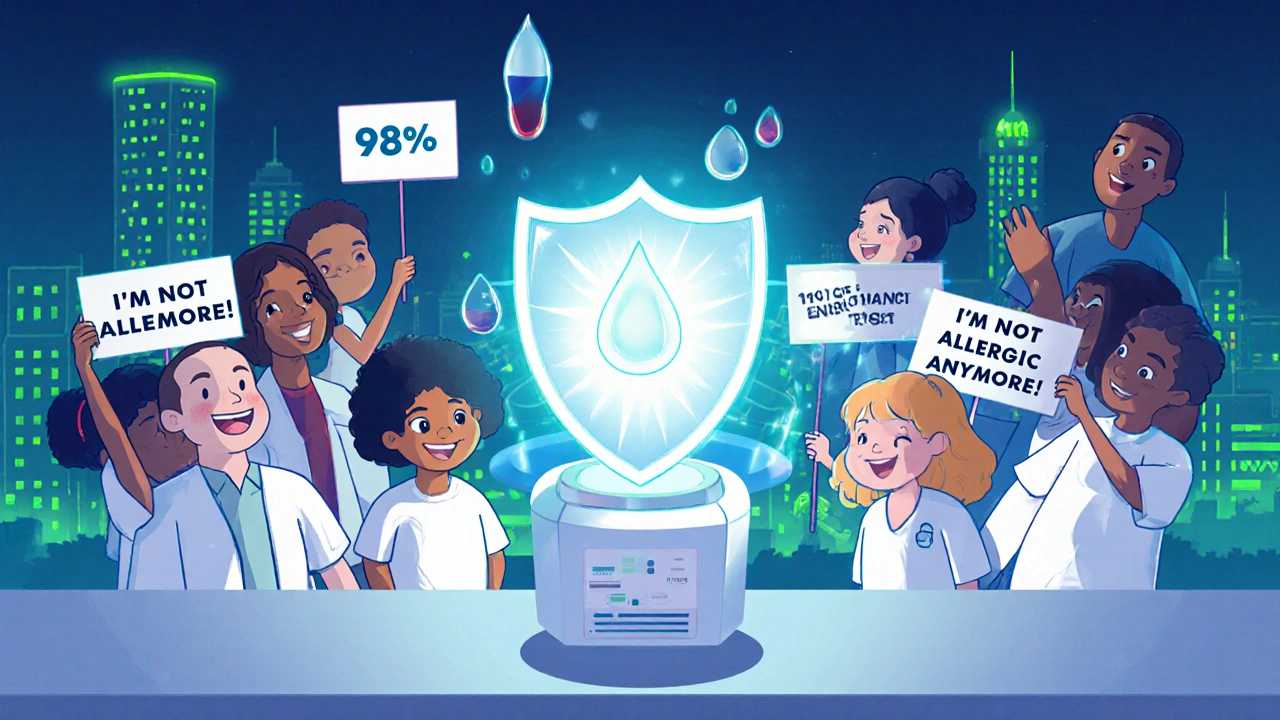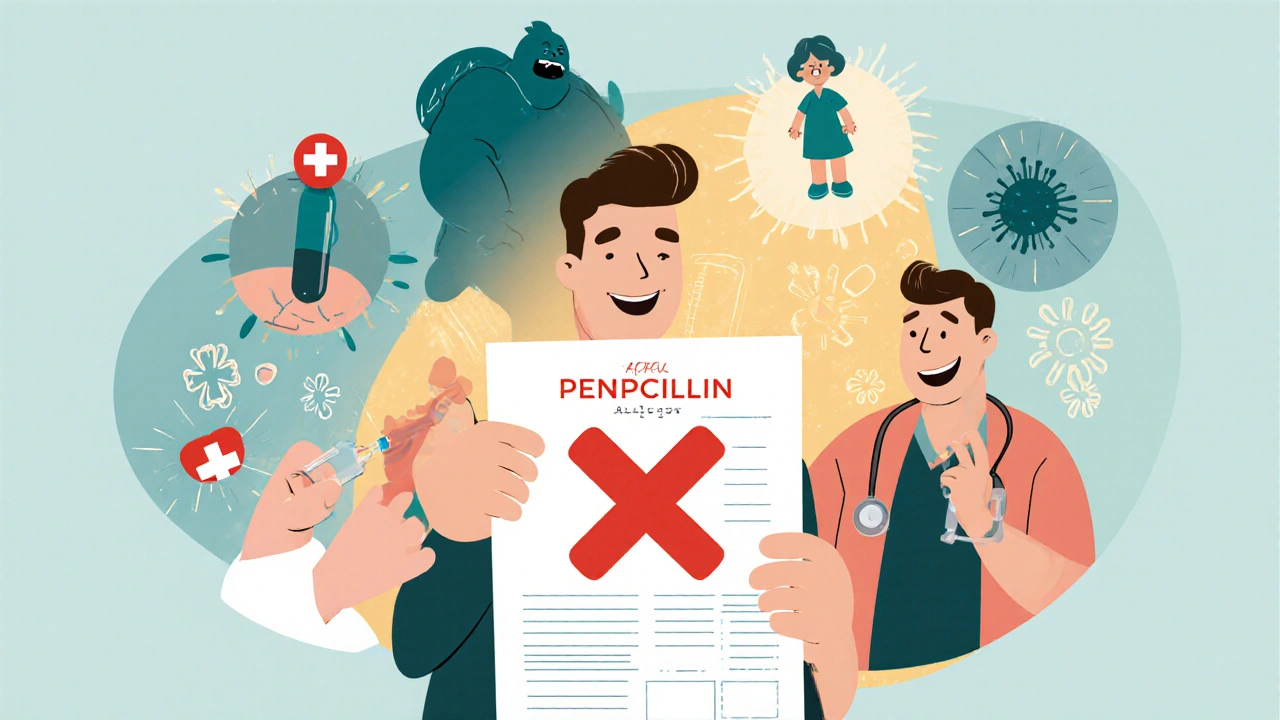Penicillin Allergy Assessment Tool
How Your Reaction History Affects Testing Eligibility
Based on CDC guidelines and the article's clinical criteria, this tool helps determine if you're eligible for penicillin allergy testing.
Your Reaction History
Your Assessment Results
Why So Many People Are Wrong About Penicillin Allergies
Almost 1 in 10 people in the U.S. say they’re allergic to penicillin. But here’s the truth: 90 to 95% of them aren’t. Most of these labels stuck from childhood rashes, stomach upset, or reactions that had nothing to do with true allergy. Years later, that label follows them into hospitals, clinics, and emergency rooms - and it’s costing lives.
When someone is labeled penicillin-allergic, doctors avoid the safest, cheapest, and most effective antibiotics. Instead, they turn to alternatives like clindamycin, vancomycin, or fluoroquinolones. These drugs aren’t just more expensive - they’re riskier. Patients with a penicillin label are 69% more likely to get a Clostridioides difficile infection, a dangerous gut bug that causes severe diarrhea and can be fatal. They’re also 50% more likely to get surgical site infections and 30% more likely to have treatment fail entirely.
It’s not just about side effects. It’s about survival. In hospitals across the U.S., avoiding penicillin because of an unconfirmed allergy is one of the biggest drivers of antibiotic misuse. And it’s entirely preventable.
How Penicillin Allergy Testing Actually Works
Penicillin allergy testing isn’t a blood test or a guess. It’s a two-step process that’s been proven over decades. First, a skin test. Then, if that’s negative, an oral challenge.
The skin test uses two key ingredients: one that mimics the main part of penicillin that triggers allergies (called penicilloyl-polylysine, or Pre-Pen), and another that catches rarer reactions (minor determinants). These are dabbed on the skin, then lightly pricked. If nothing happens, a tiny amount is injected just under the skin. The whole thing takes about 45 minutes.
If the skin test is negative - which it is in most cases - the next step is an oral challenge. The patient swallows a small dose of amoxicillin (usually 250 mg) and is watched for an hour. If there’s no reaction, the allergy label is removed for good.
This isn’t theoretical. Studies show that when both steps are done right, the chance of a future life-threatening reaction drops to near zero. That’s the same risk as someone who never claimed to be allergic in the first place.
Who Should Get Tested - And Who Shouldn’t
Not everyone needs testing. But too many people who could benefit never get the chance.
Low-risk candidates: People who had a rash more than 72 hours after taking penicillin, or who only had headaches, nausea, or a family history of allergy. These people can often skip the skin test and go straight to an oral challenge under supervision.
Moderate-risk candidates: Those who had hives, swelling, or itching within hours of taking penicillin. These people need the full skin test + oral challenge.
High-risk candidates: Anyone who had anaphylaxis, trouble breathing, or a drop in blood pressure after penicillin. These people should be referred to an allergist. Testing may still be possible, but it’s done with extreme care.
Don’t test these people: Those who had severe delayed reactions like Stevens-Johnson syndrome, DRESS, or toxic epidermal necrolysis. These are not IgE-mediated allergies - they’re dangerous immune system overreactions. Avoiding penicillin is the only safe choice.

Why Hospitals Are Starting to Take This Seriously
Back in 2016, fewer than 15% of U.S. hospitals offered penicillin allergy testing. By 2023, that number jumped to 68% for hospitals with more than 200 beds. Why the change?
Because the data became impossible to ignore.
A single course of amoxicillin costs about $35. The alternatives? Around $95. That’s a $60 difference per patient. Multiply that by thousands of patients a year - and you’re talking millions in savings. One study found that hospitals saved 0.8 days in hospital stays per patient after de-labeling. That’s fewer beds occupied, less strain on staff, and lower costs.
But it’s not just about money. It’s about better outcomes. Infectious disease experts now call penicillin allergy testing a cornerstone of antibiotic stewardship - the effort to use antibiotics wisely to protect public health. When patients are correctly de-labeled, hospitals see a 30 to 50% increase in the use of narrow-spectrum antibiotics like penicillin. That means less resistance, fewer superbugs, and fewer outbreaks of C. diff.
And it’s not just allergists doing this anymore. Pharmacists, nurses, and non-allergist doctors are being trained to run these tests. At some academic hospitals, pharmacists now handle nearly half of all penicillin allergy assessments.
What’s Coming Next - Faster, Easier Testing
The current gold standard takes an hour. But new tools are on the horizon.
A new skin test kit - combining major and minor determinants with amoxicillin - is under FDA review. Early results from a study of 455 patients showed a 98% negative predictive value. That means if the test is negative, you’re almost certainly safe. If approved, it could eliminate the need for the oral challenge entirely.
Meanwhile, pilot programs at Mayo Clinic, Johns Hopkins, and UCSF are testing rapid protocols that cut the time to under 30 minutes. These are being done by non-specialists using simplified tools. Early accuracy? 96.5% - nearly matching traditional methods.
By 2027, the CDC predicts 85% of U.S. hospitals will have formal penicillin testing programs. That could prevent 50,000 to 70,000 cases of C. diff every year. That’s not just a medical win - it’s a public health revolution.

What You Can Do Right Now
If you’ve been told you’re allergic to penicillin, ask yourself: When was the last time I took it? What actually happened? Was it a rash? A stomach ache? Did a doctor confirm it was an allergy - or was it just written down?
Don’t assume the label is permanent. Most people outgrow it. And even if you had a reaction years ago, it doesn’t mean you’re still allergic.
Talk to your doctor. Ask if you’re a candidate for testing. If your hospital doesn’t offer it, ask for a referral to an allergist or infectious disease specialist. Many clinics now offer outpatient testing.
And if you’ve already been de-labeled? Make sure your electronic medical record reflects it. Ask your pharmacist or nurse to update your file. A wrong allergy label can follow you for life - unless you fix it.
Why This Matters More Than You Think
Penicillin isn’t just another antibiotic. It’s one of the oldest, safest, and most targeted drugs we have. It kills the bacteria that cause strep throat, ear infections, pneumonia, and syphilis - without wiping out your whole gut microbiome.
When we avoid it unnecessarily, we’re not protecting ourselves. We’re making things worse. We’re choosing drugs that are more expensive, more toxic, and more likely to breed resistant bacteria. We’re increasing the chance of hospital-acquired infections. We’re making future treatments harder for everyone.
Penicillin allergy testing isn’t a niche allergy procedure. It’s a public health tool. It’s a way to use antibiotics more wisely, reduce harm, and save money. And for the vast majority of people with a penicillin label - it’s the key to safer, simpler care.
Don’t let an old label keep you from the best treatment. Get tested. Know the truth. Change your record. Your body - and your future self - will thank you.



Comments
So let me get this straight-we’re being told to trust a 45-minute skin test more than decades of medical history? Sure. And I’ve got a bridge in Brooklyn to sell you.
I had a rash at 8 after amoxicillin. My mom panicked. I’ve lived with that label for 27 years. I just got tested last month-turned out I’m fine. My doctor cried. I cried. This isn’t just science-it’s freedom.
Of course the pharmaceutical industry loves this. Less penicillin use means more profit from the ‘alternatives’ they’ve spent billions marketing. Don’t be fooled by the ‘public health’ buzzwords.
In India, we don’t even have access to these tests. We get told ‘allergy’ by a 2-minute consultation and a scribbled note. The system doesn’t care if you’re mislabeled-it just wants you to stop asking questions.
The study cited claims a 90–95% false-positive rate-but that’s based on retrospective self-reporting, not prospective, double-blind, placebo-controlled trials. The methodology is deeply flawed. Also, ‘penicilloyl-polylysine’ is not a ‘key ingredient’-it’s a synthetic hapten, and its sensitivity is only ~70%.
Let’s not forget: the FDA’s own 2021 advisory panel noted that ‘oral challenges’ carry a 0.2–0.5% risk of anaphylaxis-even in low-risk patients. And yet, we’re being urged to ‘just swallow a pill’? That’s not medicine. That’s gambling with human lives.
I wonder how many people who carry this label have never actually been tested because they’re afraid of being judged for ‘overreacting’ as kids. We treat allergies like moral failings-like if you were stronger, you wouldn’t have gotten sick. But the body doesn’t care about willpower.
I had a friend who died from C. diff after being given vancomycin because she had a ‘penicillin allergy’ from a childhood rash. She was 23. No one ever questioned the label. No one ever asked if it was real. I still dream about her. Don’t you dare call this ‘just a label’.
It’s not just about penicillin. It’s about how we treat medical knowledge: as something static, written in stone, passed down like family heirlooms. But medicine is alive. It evolves. And so do we. To cling to a childhood diagnosis like a sacred text? That’s not caution-that’s fear dressed up as care.
so like... if i got a rash when i was 5 and my mom said ‘oh no penicillin bad’ and now i’m 32 and they say ‘just take a pill’-i’m supposed to trust that? what if i die? who takes responsibility? not me. not them. just me.
My mom’s a nurse. She got tested last year. Turned out she wasn’t allergic. She said it felt like getting a second chance at life. If you’ve been told you’re allergic, please-don’t let fear keep you from the truth. Talk to someone. It’s safer than you think.
You know who benefits most from this? Hospitals. They save money. Doctors save time. Patients? We’re just data points. They’ll remove your label, then give you ten other drugs you’ve never heard of. You think this is about safety? It’s about efficiency.
I’ve been reading about this for months. The CDC data is cherry picked. The 68% hospital stat? That’s only for hospitals with over 200 beds. Rural hospitals? Zero. And the ‘oral challenge’? It’s not ‘safe’-it’s a gamble with a 1 in 200 chance of death. Who’s gonna pay for that?
Penicillin was overused for decades. Now we’re told to go back? What’s next? Reintroducing DDT? We don’t need to revive the past-we need to build better antibiotics. This feels like a nostalgic fantasy dressed up as science.